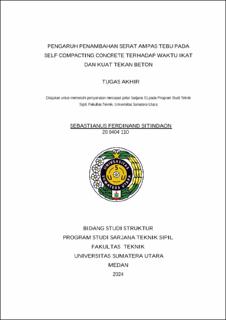| dc.description.abstract | The use of concrete is increasing along with the increasing needs of the community for infrastructure. There have been many innovations about new materials added to concrete mixes with the expectation of increasing the strength of the concrete itself and creating a building structure that is strong, durable, and environmentally friendly.One of them is the use of waste.In this study using sugarcane bagasse fiber waste from Kwala Madu Sugar Factory (PGKM) PT. In this experiment, the test specimens were made in the form of cylinders measuring 150 mm in diameter and 300 mm in height with the addition of sugarcane bagasse fiber variations of 0%, 0.25%, 0.5%, 0.75%, 1%, 1.25% and 1.5% by weight of cement. The results of testing the binding time of the 1.5% SAT variation experienced a faster binding time than the 0% SAT variation. This suggests that Sugarcane Bagasse Fiber (SAT) has an influence on the relatively faster bonding time. In the workability test, the addition of bagasse fiber at 0%, 0.25%, 0.5%, 0.75%, 1%, 1.25% met the three main criteria of SCC concrete, namely Filling Ability, Passing Ability, and Segregation Resistance, while the 1.5% variation did not meet. Thus the addition of Sugarcane Bagasse Fiber (SAT) in SCC concrete can reduce the workability of SCC. The average compressive strength values of concrete with a mixture of 0% SAT, 0.25% SAT, 0.5% SAT, 0.75% SAT, 1% SAT, 1.25% SAT and 1.5% SAT are 22.8 Mpa, 23.3 Mpa, 23.8 Mpa, 24.6 Mpa, 25.2 Mpa, 25.76 Mpa and 25.25 Mpa respectively. The optimum compressive strength value is obtained when the addition of bagasse fiber variation of 1.25% obtained a compressive strength of 25.76 Mpa. The addition of bagasse fiber exceeding 1.25% can reduce the compressive strength of SCC concrete | en_US |


